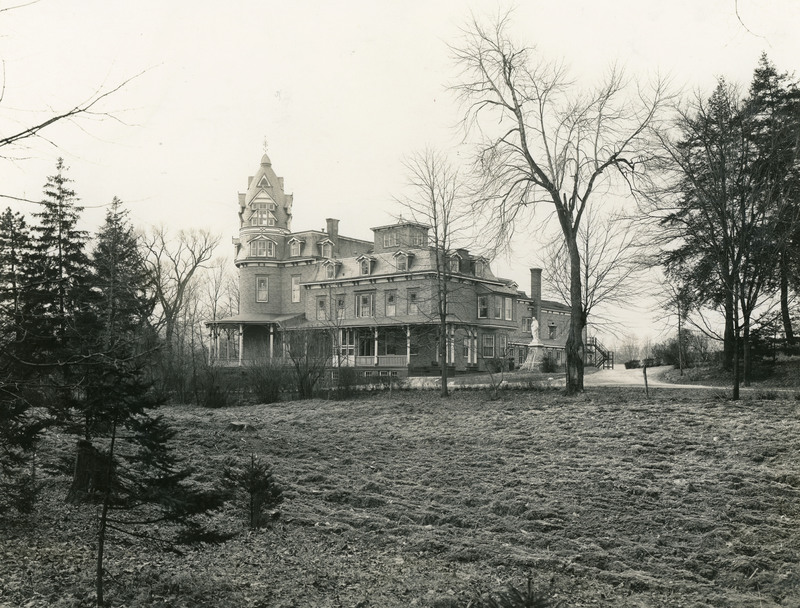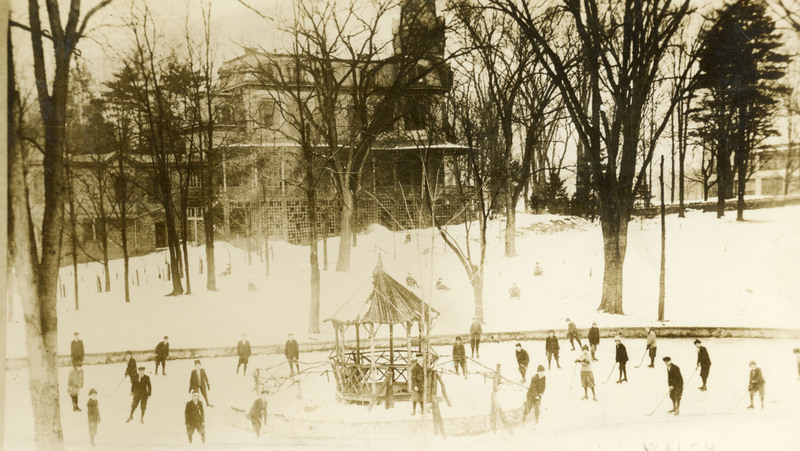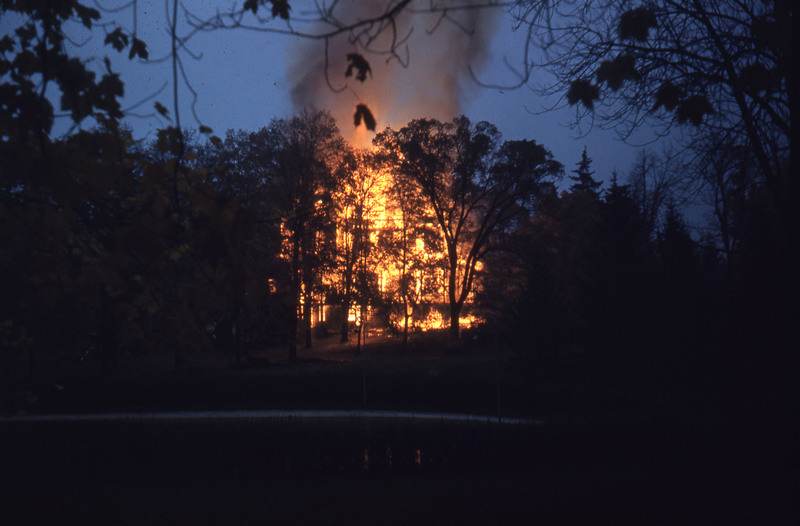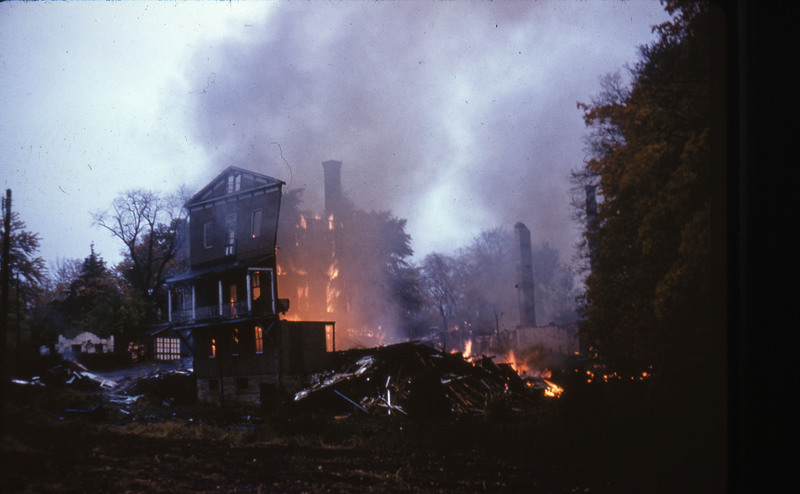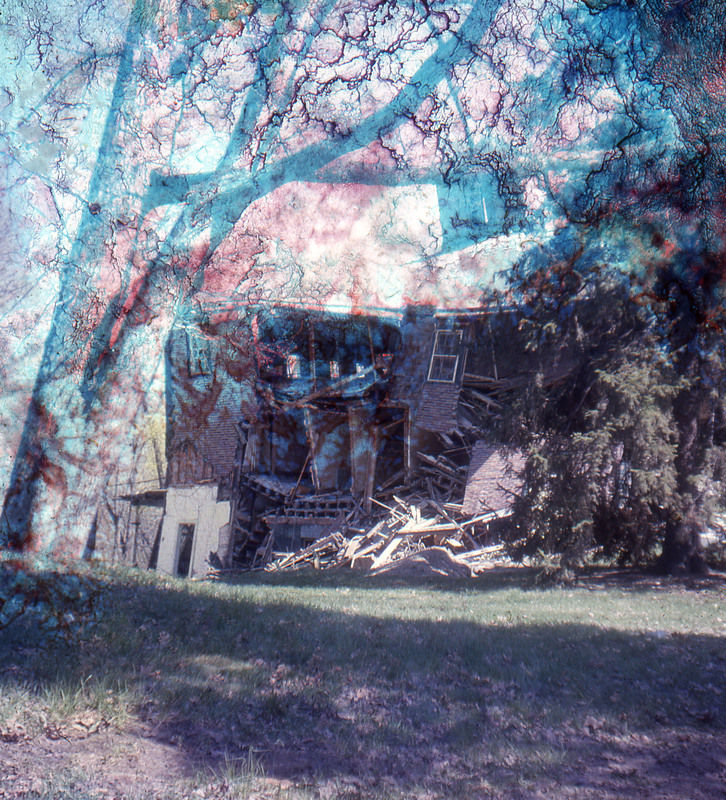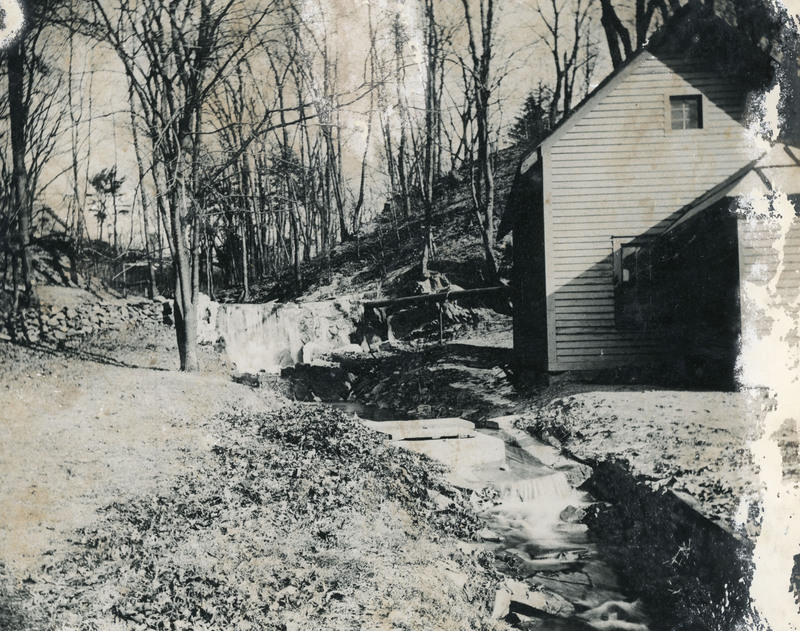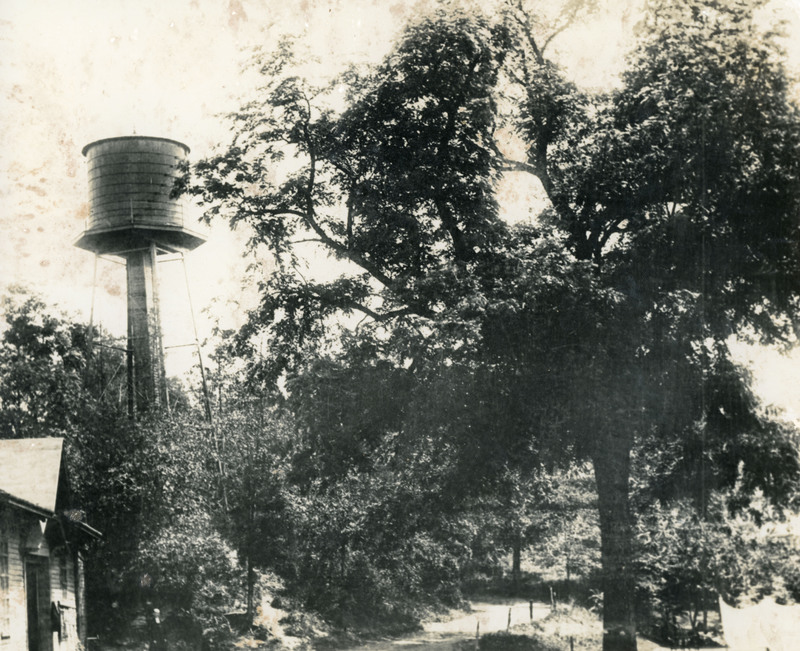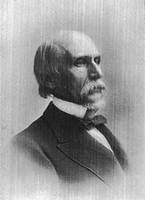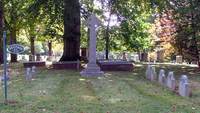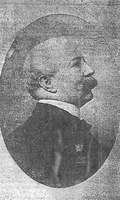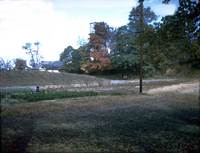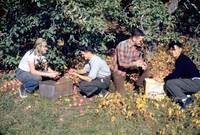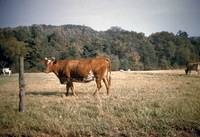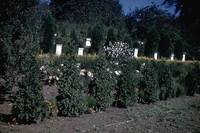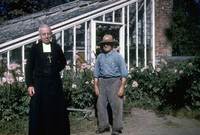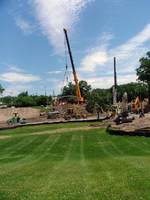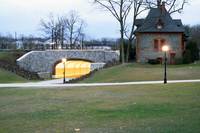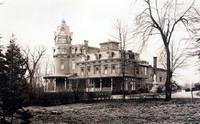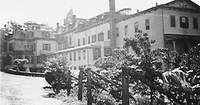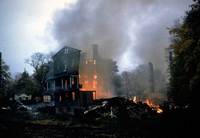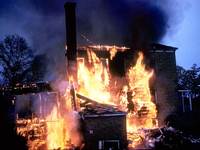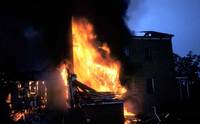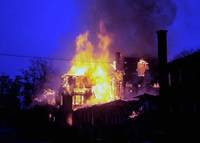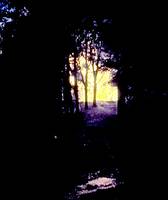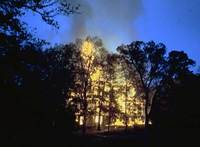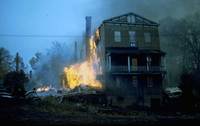MacPherson Estate (formerly Barnard Farm)
St. Ann's Hermitage (old)
The MacPherson Estate encompasses the lower section of the farm purchased by Frederick Barnard in 1817. The upper section is covered in the page on the Wood Cliff Estate. The Barnard parcel or MacPherson Estate was purchased by the Marist Brothers in 1905. In 1969 this parcel was transferred to Marist College.
This page provides the history of the property as well as its owners. Click here for a history of the building as the Hermitage.
As of 2012 the Barnard parcel contains the Lowell Thomas building, the Dyson building, the Hancock Center, the Kirk House, Upper New Townhouses, the Foy Townhouses, and the Lower New Townhouses, situated directly west and below the Hancock Center. The parcel’s southern boundary is the current Water Works road and its upper limit is just below the Fontaine Academic Building.
Barnard Farm & Family
Frederic Barnard (1780-1866) was a retired whaling captain from Nantucket Island, which was his birthplace. He moved to Poughkeepsie in 1816 with his wife Margaret (Allen) Barnard. Margaret was an Englishwoman, born in Milford Haven, near the border of Wales. The couple had twelve children. Frederic purchased the 100 acre estate formerly called Hickory Grove Farm. The deed describes the farm as lying west of the main road Highland Turnpike, south of the land of John Pells, north of the land of Abraham van Anden, and bordered on the west by the shore of the Hudson River. Shortly after purchasing farm, the Barnards sold off a six acre rectangle at the northernmost section of the farm to Elijah Martin; this strip stretched from the Highland turnpike to the Hudson River.
Whaling in Nantucket
Whaling in the late eighteenth century and early nineteenth century was centered near Massachusetts and Rhode Island, with Nantucket Island a major player. The process involved a small partnership that provided the funding for the venture. One of the partners was chosen to select the ship, hire the captain, outfit the ship and hire the crew. The partners would receive as their share one half of the cargo of a successful voyage, but would suffer the loss if the vessel were lost at sea. The partner who handled preparation for the trip would receive a double share. The other half of the cargo would go to the captain and his crew, with the captain receiving one half of that one half (or one quarter of the entire cargo) and the remaining one quarter divided among the remaining crew. If a captain commanded even a single successful expedition, he would receive a share which might enable him to retire. In the early days, a captain might make several voyages. Most of the whales were found in the North Atlantic at this time. The whale oil and blubber were prized, especially as lamp oil and lubricants for metal machinery.
Whaling along the Hudson River
As the supply of whales diminished in the Atlantic, whaling moved to the Pacific and eventually the Indian oceans. This entailed sailing the whaling ship around Cape Horn at the southern end of South America. The length of the expedition was extended, and whaling trips to the Indian Ocean commonly took two years. The hazards of rounding the Horn made the trips risky, so that less and less small groups of partners were willing to underwrite whaling ventures. The industry moved towards the Hudson River, where whaling companies arose in Hudson, Poughkeepsie, Newburgh, Peekskill and Staten Island. To raise enough capital, a corporate format was used, with investors buying stock in the company. Frederic Barnard became active with the two whaling companies in Poughkeepsie, acting as organizer of the expeditions. The companies were the Dutchess Whaling Company and the Poughkeepsie Whaling Company. His experience at Nantucket Island made him an attractive choice for the organizer. The vessels were outfitted along docks just below the current Marist Campus, on docks near Hoffman Street and Union Landing in the village of Poughkeepsie. The organizer was not a partner so he was paid to prepare the ship.
The Hudson River ventures were short-lived. As the number of investors grew, each investor’s shares lessened, so that whaling became unattractive as a financial risk. The industry practically disappeared shortly after the Civil War with the discovery of oil in Western Pennsylvania. (John D Rockefeller, Henry Flagler, and Oliver Hazzard Payne ran the Standard Oil organization from their office in Cleveland Ohio. Oliver H Payne later built an estate in Esopus, part of which was willed to Marist College in 2009. Later the founders took in another partner, Charles Pratt of Brooklyn NY, who had discovered a process to ship oil to Europe in a friendly format for lighting).
Frederic and Margaret Barnard lived with their family on the Barnard parcel for about two decades. In 1836, Barnard sold his farm to Walter Cunningham, retaining a mortgage on the parcel. About the same time, Barnard purchased two adjoining parcels along Cannon Street from Walter Cunningham and built an imposing home. This made it simpler for him to get to the whaling company docks.
Children of Frederic and Margaret Barnard
Several of the Barnard children became lawyers, of whom Joseph Folger Barnard was the most well-known and respected and George Garner Barnard was the least respected. At least one of their daughters married a Judge.
Joseph Folger Barnard was born in Poughkeepsie 18 September 1823. He graduated from Yale in 1841, then studied for the law, and was admitted to practice in 1845. He married Miss Emily Burrill Hasbrouck of Kingston in 7 January 1862. The couple had two children, Frederick Barnard (1845– 1939), who practiced law in Poughkeepsie, and Maud Barnard Banks (1862 – 1923).
Joseph Folger Barnard was born in Poughkeepsie 18 September 1823. He graduated from Yale in 1841, then studied for the law, and was admitted to practice in 1845. He married Miss Emily Burrill Hasbrouck of Kingston in 7 January 1862. The couple had two children, Frederick Barnard (1845– 1939), who practiced law in Poughkeepsie, and Maud Barnard Banks (1862 – 1923).
In 1863, Joseph Folger Barnard began thirty years’ service as a Justice of the Supreme Court in the Second Judicial District of the State of New-York, and for a large part of that time Chief Justice of the General Term of that department until his retirement January 1, 1894, having reached the age limit of seventy years. In 1871 his reelection was supported by both the Democratic and Republican parties, evidence of the respect the officials had for his judgment and impartiality. At the time of his death in January 1904, Justice Barnard owned several farms in Dutchess County, and took great pleasure in supervising them. Justice Barnard was respected for his fairness, the quality of his decisions, and his work ethic. He often was the first to arrive at the courthouse and the last to depart.
Joseph Folger Barnard’s siblings are listed as: William Frederick Barnard, Thomas Allen Barnard, Robert S Barnard, Margaret Allen Barnard, Frederic M Barnard, Martha Barnard, George Gardner Barnard and John Barnard.
George Gardner Barnard (1829 – 1879), on the other hand, had a more colorful history. He too graduated from Yale in 1847, and studied for law under his brother Joseph Folger Barnard. He went to California and practiced law there, but returned in 1856 to New York City to practice law. In 1857 he was elected on the Tammany Hall ticket as Recorder of New York City, a position he held until 1860. In November 1860 he was elected to an eight year term on the Supreme Court, and was again elected in 1868. He became involved in a messy railroad dispute over the Erie Railroad. Several of his actions as judge favored Jay Gould (1836-1892) and James Fisk (1835-1972). As a result he was impeached by the New York State Assembly, tried in 1872 by an impeachment court, found guilty and removed from office. Although never charged with any crime, he was barred from holding public office in New York State. Barnard died from Bright’s disease. Viewing was held at his residence at 23 West 23rd Street with many notables in attendance. Burial was in Greenwood Cemetery, Brooklyn NY.
Owners after the Barnards
Walter Cunningham was engaged in real estate. Like many others, he purchased and sold properties; today real estate agents or brokers usually act as middlemen between grantor and grantee. In the 19th century, the real estate agent became an intermediate owner. It is doubtful if Cunningham ever lived on the Barnard property. Cunningham then sold the property to Henry S. Richards who like Cunningham seems to have been occupied with real estate. The sale included all of the Barnard property except that sold by Barnard to Elijah Martin. Richards sold the southern 60 acres of the farm to Sarah Bailey in 1841. The purchase price was $12,000, but the Oakleys assumed $6,000 of the mortgage originally granted to Cunningham by Barnard. In 1844 Richards purchased the Elijah Martin farm. Elijah had purchased the farm from Frederic Barnard in 1819. It was a ten acre lot reaching from the Hyde Park Road to the Hudson River. The net effect of these transactions was to split the original Barnard farm into two, with Oakley owning the lower two-thirds and Richards owning the upper third.
During the next four decades there were many short term owners (Stephen Baker the only owner holding the land for more than a decade. Most of these were from New York City or Brooklyn or New Jersey looking for a place in the ‘country’. The Hudson River Railroad Company Railroad map submitted to the county officials shows details of the owners as of 1848.
The owners north of the waterworks road, in north to south order were:
| Owners from north to south |
Length of track in feet |
|---|---|
|
Estate of James Pell, deceased |
624 |
|
adjoining Van Schoonhoven |
216 |
|
James Van Schoonhoven |
780 |
|
Charles Trotter |
1007 |
James Roosevelt owned land directly north of the Pells parcel. The division line between Roosevelt and Pells was the beginning of Hyde Park town. The Pell parcel west of the Hyde Park Road became the Newbold estate in 1861. Van Schoonhoven became the estate of John F Winslow. Adjoining Van Schoonhoven was probably the farm of Elijah Martin.
The most notable owners before the Marist Brothers were the MacPhersons.
Cordelia and Thomas MacPherson
Thomas MacPherson was Cordelia’s third husband. Her maiden name is unknown, but her first husband was Gardiner C. Yvelin, who was born in Versailles, France 21 December 1793. The couple lived in New York City and had at least two children, Cordelia E Yvelin, born 6 May 1863, and Gardner Yvelin, born about 1874. Given these birth dates, Cordelia married Gardiner in 1861 or 1862, when she was 18 or 19 years old and Gardner was in his late sixties. In the 1850s, Gardner G Yvelin lived at 149 Lexington Ave in Manhattan, New York City and was a fruit importer. By the 1870s, the Yvelins were living at 563 Fifth Avenue, again in Manhattan. Gardner Yvelin died 19 June 1876 and was buried in Greenwood Cemetery, Brooklyn NY.
Cordelia then married Andrew Boardman, widower, a New York City lawyer who was born in England around 1824. Andrew had several children from a previous marriage, and Andrew and Cordelia had a son. The Boardman residence was in New York City, but Andrew had developed extensive holdings in Poughkeepsie. The estate named Cliffdale was located near Vassar College and Boardman Road (The Boardman obituary locates the estate near the “driving park” along Hooker Avenue in Poughkeepsie NY. Nineteenth century maps place the driving park near Wilbur Boulevard), and it eventually became part of the research center of IBM.
After Andrew Boardman’s death, Cordelia met Thomas J MacPherson in New York City through their common musical interests. The couple was married about 1882; Thomas was about 11 years younger than Cordelia. They first lived in Cliffdale, but moved to Hyde Park Road after Thomas J MacPherson purchased the lower section of the Barnard parcel from John H. Butler and wife. The Butlers lived in Jersey City NJ; it is not known how active they were in maintaining the Barnard parcel along the Hyde Park Road during their two year ownership period.
The MacPhersons set about renovating the main house. To do this they took out three mortgages to Cordelia MacPherson. In May 1892 Thomas MacPherson transferred complete ownership to Cordelia MacPherson. It is likely that the financing of the purchase and the improvements were bankrolled by Cordelia’s resources.
Thomas J MacPherson was born in Trenton NJ. His father, Thomas J, is listed in the 1880 census as a lumber dealer, age 73; both he and his parents were born in New Jersey. Thomas’ mother, Ellen, age 64, was the daughter of a father born in Ireland and a mother born in Delaware. Thomas J, our person of interest, was 24 and listed as a music teacher. His sister Ella, age 25, was listed as a school teacher, but later became a principal and superintendent of schools in Trenton. His younger brother George, age 22, is listed as a lawyer. All three children were born in New Jersey (US Census record 1880 NJ, Mercer County, Trenton for Thomas J MacPherson lists Thomas’s father, mother Ellen, sister Ella, and brother George. Earlier census records (1870, 1860, 1850 show older siblings: Sarah H born 1836 and a schoolteacher, Charles K born 1845, Jane or James E, born 1847, Joseph born 1836, and John W born 1838. There is no wife listed in the 1850 census, which leads me to believe that Ellen was a second wife). While still in his teens, Thomas went abroad to study music, receiving most of his musical training in London, Paris and Dresden. Before he was twenty years old he organized vocal classes for men in Trenton. He was director of the Eight O’clock Club, composed of male voices. He was also director of the Third Presbyterian Church of that City.
The MacPhersons lived on the Barnard parcel until the Cordelia died 1893. After her death, Thomas moved to the city of Poughkeepsie, first at the Hasbrouck house on Market Street, and later to the Dr. Campbell house on Mill Street until he purchased the place at 67 Catherine Street, where he lived until his death in 1908.
“Mr. MacPherson entered at once upon the work as choirmaster of the Washington Street M.E. Church. He began teaching and drilling the various church choirs of the city. In turn, nearly every choir in town, including those of the Catholic Churches, came under his instruction…. It was during the pastorship of Father Nilan at St. Peter’s Church that MacPherson instructed both the choirs of that church and St. Mary’s Church.” (from 1890 obituary)
While working with the choirs, MacPherson identified gifted private pupils, so that almost every choir in the city featured the presence of MacPherson students.
MacPherson also founded the Euterpe Glee Club and for fifteen years was its director. While Cordelia MacPherson was alive, the Euterpe held concerts in her house, as she was known as a grand entertainer, and she greeted cordially the poor and rich alike.
After Cordelia MacPherson’s death, the house and property were purchased at public auction for $35,600 by her daughter, Cordelia E Yvelin, then living in New York City, acting on behalf of the estate of Gardiner Yvelin that held the three mortgages. She probably bid this high to cover the amount of the mortgages and prevent others from purchasing the estate without assuming the mortgages.
In 1897 Cordelia E Yvelin, again acting for the Yvelin estate then sold the property listed as 50 acres (less some prior transfers) to Gilbert Smith Coddington of New York City for $14,500.
Gilbert Smith Coddington died around 1900, so the Poughkeepsie property remained unoccupied for at least five years before the Marist Brothers purchased it via the intermediary of Brother Louis Zepheriny, who acted on the commission of the Brother Provincial and the superiors in France.
The Search for a Novitiate
After being commissioned to find a suitable location for a training center/Juniorate, Zepheriny, acting on the advice of the Redemptorist Fathers from Baltimore, looked in Ulster County, where he had been told there were properties available. In 1903, the Redemptorist Fathers had located their seminary in Esopus along the Hudson River. It is likely that Zepheriny looked at the vacant Pratt estate and the vacant Niedlinger estate, both of which figure prominently in the later history of the Marist Brothers in Ulster County. But he decided against Ulster for two reasons: the Redemptorists could not guarantee chaplain service , and the transportation between New York and Montreal was better on the east side of the Hudson River.
Zepheriny then turned to his friends among the Jesuits, who staffed Saint Ignatius Loyola Church, a few blocks from Saint Ann’s Academy. He was directed to the Rector of the Jesuit Seminary which had relocated from Ulster to Dutchess. Father Joseph Haven Richards SJ identified two vacant estates, the former MacPherson property and the Bech property just below.
The Annals of St. Ann’s Hermitage 19904-1934 indicate that Brother Zepheriny looked at both sites. He preferred the Bech property, but it was too costly to consider at that time.
Another legend about Brother Zepheriny is that he alerted his superiors in France that a property across the Hyde Park Road of 372 acres was available at a very reasonable price. This parcel had been purchased by George Bech, son of Edvard and Elizabeth Bech in 1881. George died in 1886, but Elizabeth held on to the parcel until her death in 1900. When his superiors asked him what he would do with 372 acres, he replied that the Jesuits had purchased 1000 acres in Hyde Park. Brother Zepheriny’s suggestion was rejected by his superiors.
The MacPherson property was reasonably priced and available. So Zepheriny bought it in his own name. This may have been because the Brothers were not yet incorporated in the United States, or it may have been to deflect anti-Catholic bias common at that time. Since the Brothers had no financial resources, Zepheriny used $7,400 from funds belonging to his patrimony – money willed to him and owned by him, but usually not allowed to be used by him. It could be willed to successors; it might also become available to him if he left the Marist Order. These are provisions of Canon Law applicable to members of religious orders. He was chided for this action by the superiors in France when they discovered his actions. This made him more circumspect when he negotiated the purchase of the Bech property in 1908.
The main house had not been lived in since the MacPhersons, and was in run down condition. But it had potential for use as a Juniorate. The large and beautiful rooms inside the building could be easily adapted to religious use: chapel, classrooms, dormitory on the top floor.
“The house was said to be haunted. So much so that one day when Brother Provincial and Brother Ptolemeus came to visit it , the driver advised them not to buy that house because it was the devil’s quarters. Our visitors calmed the good fellow by telling him nicely that that was the very reason why they wanted to buy it.” (Annals of St. Ann's Hermitage).
The purchase of the MacPherson/Coddington property, about 35 acres, went through on 28 February 1905. Several Brothers transferred to the property and spent the next year repairing and remodeling the house for use as a Juniorate. The first Juniors came from the French-speaking Juniorate in St. Hyacinthe, Canada on 21 February. The property was named Saint Ann’s Hermitage on the urging of Brother Zepheriny.
Three of the first Juniors were sent to St. Hyacinthe, Canada for their Novitiate, conducted in French. The Brothers realized it imperative to establish an English speaking Novitiate, and commissioned Brother Zepheriny to again look at the Bech estate site. He managed to purchase the Bech property on 27 August 1908. (Elizabeth Bech left the property to her granddaughter, the daughter of Elizabeth’s son Henri Bream. She was married to royalty in Europe, and commissioned Nicholas Jungeblut to sell the property). During the period 1905 to 1908, the properties were owned in the name of Louis Zepheriny. Immediately after purchasing the Bech property, Brother Zepheriny transferred both parcel to the Marist Brothers. Details concerning this transaction may be found in the section on the Bech Estate. The remainder of this page concentrates on the usage of the Barnard parcel during the Marist Brothers’ ownership.
Besides use as a Juniorate, the Barnard property housed Brothers who worked on the property (and later the Bech property), a separate section for retired and disabled Brothers, and administrators for the entire United States Province. During the first twenty years four Brothers were busy as carpenters renovating or building. The first major renovation was a box-like addition to the west end of the MacPherson house, providing room for kitchen and dining facilities for the Juniors and for all the Brothers who worked on the properties, as well as housing for the retirees, disabled, working Brothers and faculty of the Juniorate. The combined Bech/Barnard farming operation was based in the original barn area, with land in the Barnard sector used for plantings and grazing, raising of pigs and chickens. The Brothers constructed a silo for the barn. The Surrogate Court papers for Cordelia MacPherson list ends the list of personal property with a final item: Black cow in barn area, value $26. So we know the barn was in use during the MacPherson ownership, but the usage was minimal. Given the influx of Brothers and candidates for the Brotherhood, the volume of the operation had to be expanded.
The southern part of the Bech property was dedicated to an English-speaking Novitiate. The northern section, named “Central” included the Gate House, Gardener’s Cottage, Carriage House and related buildings. This section became the site for advanced study after the Novitiate years, eventually leading to the establishment of Marist Training School in 1929.
As early as 1927, the future Superior General of the Marist Brothers visited the campus and urged them to provide better housing for the residents in both the MacPherson house and the Bech house (then in use as a novitiate). It is believable that someone from Europe, accustomed to stone houses, sensed the danger of older wood frame housing. Later the same Brother was elected Superior General. In 1939, durng his term as Superior General, the US Provincial Council submitted a request to build a new provincial house in Poughkeepsie. At first it was approved, but with the beginning of World War II, construction was delayed indefinitely.
This arrangement lasted until 1942, when more space was needed for the Juniorate. The Brothers purchased 200 acres of the Payne Estate in Esopus between route 9W and the Hudson River and moved the Juniorate there. This freed up space in the MacPherson building dormitories so that the Student Brothers relocated their dormitory space away from Central. The Brothers continued to use the chapel, kitchen, and dining rooms in the older MacPherson house. The infirmary and retirement groups also remained in MacPherson.
In the early 1950s, Francis Cardinal Spellman urged the Brothers to abandon housing in the MacPherson building, as it was a potential fire hazard. (The Novitiate which had been housed in the Bech house had been relocated to Tyngsboro MA.) Cardinal Spellman was very much aware of a tragic event in the Chicago diocese which resulted in loss of many lives, and wanted no repetition here in New York. However, the New York diocese was not in a position to fund any changes, so the timetable had to be delayed several years until the Brothers could gather together the funds for new space.
The Brothers did the construction themselves, starting with the Chapel of Our Lady Seat of Wisdom in 1953. By 1956, they built a combination study hall dining room attached to the west end of the chapel, and by 1957 had added a three story fireproof dormitory to the study hall/dining room. This meant the Marian College operation could move to the Bech campus. The few remaining retired, disabled, and working Brothers were relocated to other Marist Brothers sites, so the building was empty.
A contract to demolish the building was given to a construction company in Pleasant Valley. The company obtained a permit to burn the building, which it did in fall 1957. This created a spectacular fire directly across from the Western Printing factory. The wind was strong, and Harold Spencer, one of the founders of Western Printing said that fiery cinders the size of softballs flew over Route Nine and landed on the factory roof. Luckily no one was injured. The fire department was slow to respond, which led to finger pointing in several directions.
Interesting Tidbits about the Marist Brothers’ occupancy
“March 1909. On the 3rd of this month the very small house near the Juniorate barns, which served as laundry room, went up in flames during the night. Everything was burned. Insurance covered part of the fire. Mrs. Winslow, our neighbor, sent us $50 to help out” (Annals of St. Ann's Hermitage).
“July 26, 1910 A magnificent statue of St. Ann, gift of Mrs. F. Foley, was blessed by Rev. Father Williams, and , in the presence of the entire Community, was put up near the entrance to the Juniorate, on a cement pedestal made by Bro. Titian” (Annals of St. Ann's Hermitage).
There was a small stream onto the property from Mrs. Winslow’s property immediately to the north. This stream is marked on early maps as originating at the northeast edge of the Ziegler property (just north of the Winslow farm property east of Route Nine), crossing the Winslow farm, and then tunneling under route nine. In his estate west of route nine, Winslow created several small ponds, in one of which he placed an island in the shape of the Monitor, the warship he had managed to get built during the Civil War. The stream on the Winslow Farm property can be seen entering the culvert under route nine, near the fence for the road Winslow Gate Road, at the blinker just north of the regular traffic light near MacDonalds and the Mobil station. In many cases, these streams emptied into the Hudson. After route nine was built, the streams retained the right to cross under the road and continue their journey to the Hudson. The construction of Donnelly Hall encountered such a stream as the Brothers attempted to pour foundations for the southern half of the circle.
The enterprising Brother Leo had the Brothers build a dam on the stream on the Marist property, and used the dam to generate enough hydroelectric power to light the MacPherson house.
End of the Marist Brothers ownership
In 1961, the Brothers had transferred ownership of the property south of the Water Works Road to Marist College, basically to facilitate mortgages for the Sheahan, Leo, and Champagnat Dormitories but they kept ownership of the property north of the Water Works.
The Marist Brothers transferred ownership of the property north of the water works road to Marist College in 1969.
This ends the saga of the Marist Brothers’ ownership of property now part of Marist College. (Source: Marist College Land History: Barnard Parcel)
Notes
Note 1. Some details during the Marist Brothers ownership may be found in the chapter on the Bech estate. This relates especially to the information supplied by Brother Nilus Donnelly and the Annals of St Anne’s Hermitage 1905 – 1934.
Note 2. Deed 21 Jan 1817 liber 26 page 41 Peter Morgan and Elizabeth his wife to Frederick Barnard
Deed 28 Feb 1905 liber 338 page 376 Coddington estate to Louis Zepheriny
Gilbert Coddington’s cousins, Clifford C and Henry S were executors of the Coddington estate.
Deed 27 August 1908 liber 359 [age 454 Louis Zepheriny to Marist Brothers
Deed 25 February 1969 liber 1261 page 51 Marist Brothers to Marist College
Note 3. Information about Frederic and Margaret Barnard derived from New York Times article November 12, 1891, on the occasion of their Judge Joseph Folder Barnard’s retirement
Note 4. The name Hickory Grove Farm is cited in the archival survey for the Wood cliff Estate dated September 2009 by Hart gen Archeological Associates, Inc. page 6
Note 5 1817 21 Jan 1817 liber 26 page 41 Peter Morgan to Frederick Barnard deed recorded with Dutchess County clerk.
Note 6, 1819 1 May 1819 liber 34 page 194 Frederick and Margaret Barnard of Poughkeepsie to Elijah Martin of the same place.
Note 7. The companies were the Dutchess Whaling Company and the Poughkeepsie Whaling Company.
Note 8. John D Rockefeller, Henry Flagler, and Oliver Hazzard Payne ran the Standard Oil organization from their office in Cleveland Ohio. Oliver H Payne later built an estate in Esopus, part of which was willed to Marist College in 2009. Later the founders took in another partner, Charles Pratt of Brooklyn NY, who had discovered a process to ship oil to Europe in a friendly format for lighting.
Note 9. 1836 liber 61 page 141 Frederic & Margaret Barnard to Walter Cunningham
1836 Book of mortgages liber 48 page 258 Walter Cunningham to Frederic Barnard. Later Barnard transferred this mortgage to a group headed by Benjamin Bonney.
Note 10. 1836 liber 61 page 139 Walter Cunningham to Frederic Barnard, main parcel along Cannon Street
1837 liber 62 page 47 Walter Cunningham to Frederic Barnard, small addition to Cannon Street parcel
Note 11. Information of children’s names and dates of birth and death obtained through Chalmers Hall Bache family tree listed in Ancestry.com. Joseph Flogger Barnard’s siblings are listed as: William Frederick Barnard, Thomas Allen Barnard, Robert S Barnard, Margaret Allen Barnard, Frederic M Barnard, Martha Barnard, George Gardner Barnard and John Barnard.
Note 12. Deed 27 Nov 18378 liber 63 page 345 Walter Cunningham of Poughkeepsie to Henry S Richards of New York City. The sale included all of the Barnard property except that sold by Barnard to Elijah Martin
Note 13. Deed 9 January 1841 liber 69 page 556 Henry S Richards and wife of Poughkeepsie to Sarah Oakley wife of Samuel Oakley. Purchase price was $12,000, but the Oakleys assumed $6,000 of the mortgage originally granted to Cunningham by Barnard.
Note 14. Deed 6 May 1844 liber 78 page 85 Elijah Martin to Henry S Richards. Elijah had purchased the farm from Frederic Barnard in 1819 see liber 34 page 194. It was a ten acre lot reaching from the Hyde Park Road to the Hudson River.
Note 15. See chapter on the Winslow property to learn details about the upper one third of the Barnard farm.
Note 16. Copy of the map furnished by the Hudson River Railroad Company to the County can be located in the Records Office of the County Clerk, County office building , Market Street, second floor. The copy is on a roll of paper about 24 feet long, but may be rolled out along one of the long tables. Individual parcels are given sequential code numbers. Some parcels have two code numbers, one for the land above high water, the other for land below high water.
Note 17. The Boardman obituary locates the estate near the “driving park” along Hooker Avenue in Poughkeepsie NY. Nineteenth century maps place the driving park near Wilbur Boulevard.
Note 18. The obituary for Mrs. MacPherson indicated that they married about 1887 and then bought the Barnard parcel. This is not consistent with the purchase listed in the deeds (1885) or the obituary for Thomas MacPherson which indicated that he came to Poughkeepsie about 1882.
Note 19. Deed 18 April 1885 liber 229 page 559 John H Butler and wife to Thomas J MacPherson.
Note 20. Mortgage 7 Sept 1887 liber 197 page 230 MacPhersons to Cordelia MacPherson
Mortgage 20 Nov 1889 liber 265 page 213 for $6000 MacPhersons to Cordelia MacPherson
Mortgage 20 May 1890 liber 207 page 314 $ ? MacPhersons to Cordelia MacPherson
Note 21. Deed May 1892 liber 270 page 463 Thomas J MacPherson to Cordelia MacPherson
Note 22. US Census record 1880 NJ, Mercer County, Trenton for Thomas J MacPherson lists Thomas’s father, mother Ellen, sister Ella, and brother George. Earlier census records (1870, 1860, 1850 show older siblings: Sarah H born 1836 and a schoolteacher, Charles K born 1845, Jane or James E, born 1847, Joseph born 1836, and John W born 1838. There is no wife listed in the 1850 census, which leads me to believe that Ellen was a second wife.
Note 23. The material in this and the following paragraphs is based on the obituary published February 11, 1890.
Note 24. Quoted from the February 11, 1890 obituary.
Note 25. Euterpe, from the Greek culture, is one of the nine Muses of Apollo. Her name means "rejoicing well" or "delight". She was born from Zeus and Mnemosyne, the goddess of memory, along with her other eight sisters. Euterpe is the Muse of music and lyric poetry. She is also the Muse of joy and pleasure and of flute playing and was thought to have invented the double flute, which is her attribute. The title Euterpe Glee Club was in common use during the nineteenth century for men’s choral groups.
Note 26. Foreclosure deed 24 May 1894 liber 275 page 31 Isaac Bingham, referee for the MacPherson property to Gardiner Yvelin.
Note 27. Deed 9 October 1897 liber 294 page 11 Cordelia Yvelin to Gilbert Coddington
Note 28. Information on the Marist Brothers in North America is based on the work of Brother Leonard Voegtle, fms Go to the Land I Will Show You Marist Press 1995 Volume 1, 1885-1911, New France, New England, New York, 207 pp.. Available in the Marist College Archives. This was the first of three planned volumes. Brother Leonard was researching the second volume when he died in 31 March 2001. His work papers are on file at the Marist Brothers Archives, Marist Brothers, Box 197, Esopus NY 12429 Attn: Brother Bryce Byczynski
Note 29. The source for information about Brother Louis Zepheriny is derived from the obituary by Bro. Joseph Belanger found at http://academic2.marist.edu/foy/maristsall/obits/zepherenybrochier. See also Brother Leonard Voegtle Go to the Land I Will Show You, pp.95-102
Note 30. Annals of St. Ann’s Hermitage 1904-1934, translated from the French by Bro. Joseph L. R. Belanger, fms, Marist College Press, Poughkeepsie NY 12601, published 2002. Page 3 Available at Marist College Library Archives.
Note 31. Annals of St. Ann’s Hermitage 1904-1934 page 10. Available at Marist College Library Archives.
Note 32. Deed 15 dec 1881 liber 207 page 281 Thomas L Davies, dec’d to George A Bech 372 acres for $38,000
Deed 18 may 1907 liber 359 page 183 George A Bech Estate & Henry Bream to Fairview Improvement Co, 372 acres for $13,400 ??? (check this)
Note 33. These are provisions of Canon Law applicable to members of religious orders.
Note 34. Annals of St. Ann’s Hermitage, page 4 The earliest photo we have of the house indeed seems to be that of a haunted or mysterious house!
Note 35. Deed 27 August 1908 liber 358 page 402 Nicholas & Gertrud Jungeblut to Louis Zepheriny Elizabeth Bech left the property to her granddaughter, the daughter of Elizabeth’s son Henri Bream. She was married to royalty in Europe, and commissioned Nicholas Jungeblut to sell the property..
Note 36. During the period 1905 to 1908, the properties were owned in the name of Louis Zepheriny Immediately after purchasing the Belch property, Brother Zepheriny transferred both parcel to the Marist Brothers. See deed 27 August 1908 liber 358 page 454 Louis Zepheriny to Marist Brothers.
Note 37 The Surrogate Court papers for Cordelia MacPherson list ends the list of personal property with a final item: Black cow in barn area, value $26. So we know the barn was in use during the MacPherson ownership, but the usage was minimal. Given the influx of Brothers and candidates for the Brotherhood, the volume of the operation had to be expanded.
Note 38. Gerard Weiss, graduate from Marian College in 1949, was teaching Spanish at Marian. He managed to take some spectacular photos of the fire.
Note 39. Annals of St. Ann’s Hermitage 1904-1934 page 17
Note 40. Annals of St. Ann’s Hermitage 1904-1934 page 22
Note 41. The stream on the Winslow Farm property can be seen entering the culvert under route nine, near the fence for the road Winslow Gate Road, at the blinker just north of the regular traffic light near MacDonalds and the Mobil station. In many cases, these streams emptied into the Hudson. After route nine was built, the streams retained the right to cross under the road and continue their journey to the Hudson. The construction of Donnelly Hall encountered such a stream as the Brothers attempted to pour foundations for the southern half of the circle.
Note 42. Daniel Kirk died in 1984. The house became part of the estate. By terms of the original lease, the college and estate executor would agree on a common value for the house, and the college would pay the estate that value, take possession of the house and terminate the lease.. See release dated 15 July 1985, liber 1675 page 209 . The mortgage taken out by Kirk (original principal of 36,500 was paid off at the time of the release, using proceeds of the $100,000 payment from Marist College.
Note 43. The new houses were named Gregory after Brother Joseph Gregory Marchessault, a physics teacher at Marist who died young, and Benoit after Brother Francis Xavier Benoit, who taught for many years in Marist Training School and Marian College
Note 44. See deed 25 February 1969 liber 1261 page 61 Marist Brothers to Marist College
Research on this project was conducted from January 2008 through August 2012 by Richard Foy, assisted by student assistants Paul Contarino and Kayla Benefield.
This is a list of deeds which are on file at the Dutchess County Office Building with the County Clerk (second floor). It was not thought useful to provide the full text here as it is readily available at the office of the County Clerk.
Deed Legend:
year=the year recorded with the clerk
date=date marked on the deed itself
liber=book in which deed is listed
page=page of the liber book
description=description of deed
grantor=individual or group originally holding deed
grantee=individual or group taking title to the deed
|
Year |
liber |
page |
description |
grantor |
grantee |
| 0 | 0 | 0 | notes on outdoor swimming pool | ||
| 0 | 0 | 0 | survey map for Gregory and Benoit buildings | ||
| 1748 | 2 | 153 | Lbs 120 land above Abraham De Graef | Michael Palmatier | Miguel Pells |
| 1791 | 13 | 144 | 80+ acres bounded N & S by Pells | Jacobus & Adrian Palmatier | Jacobus Palmatier |
| 1798 | 15 | 328 | 3 acres south of Palmatier, north of Richmond | John Richmond & Mary wife | Jacobus Palmatier |
| 1813 | 26 | 564 | $1047 104 acres between Pells and Van Anden | Samuel Slee | Peter B Morgan |
| 1814 | 23 | 496 | $1000 2 acres town of Poughkeepsie | William Davies & Polly wife | John E Pells & Thomas Talmadge |
| 1816 | 26 | 565 | Mary gives up her right of dower to Palmatier land | Mary Palmatier | Peter B Morgan |
| 1817 | 26 | 41 | $4,500 100 acres north of Van Anden land | Peter Morgan & Elizabeth | Frederic Barnard |
| 1819 | 34 | 194 | $327 acres northern section of Barnard parcel | Frederic Barnard & wfr Margaret | Elijah Martin |
| 1824 | 40 | 488 | release of land from mortgage | Benjamin Delavergne | John Given |
| 1834 | 54 | 264 | $800 parcel near Union & Hoffman Sts | Frederic Barnard & wfr Margaret | Stephen McCarty |
| 1836 | 61 | 141 | $14,000 100 acres | Frederic Barnard & Margaret | Walter Cunningham |
| 1837 | 61 | 139 | $8,000 parcel north side Cannon St | Walter Cunningham | Frederic Barnard |
| 1837 | 63 | 344 | release of mortgage for sale to Richards | James Emmott | Walter Cunningham |
| 1837 | 62 | 43 | $400 parcel adjacent to Barnard on Cannon St | Walter Cunnigham | Frederic Barnard |
| 1838 | 64 | 71 | $600 parcel along Union Street | Frederic Barnard & wfr Margaret | John I Hebaro |
| 1838 | 63 | 345 | $30,000 southacerage of Barnard farm | Walter Cunningham & wife Elizabeth | Henry S Richards |
| 1841 | 70 | 60 | $11,000 60 acres 2/3 of Barnard farm | Samuel Oakley & wife | William H Fells |
| 1841 | 69 | 556 | $12,000 60 acres 2/3 of Barnard farm | Henry S Richards & wife | Sarah Oakley |
| 1843 | 76 | 106 | $9000 60± acres | William H Fells & wife | John W Latson |
| 1847 | 84 | 356 | Richards $10,000 27 acres | Benjamin Bonney | James Van Schoonhoven |
| 1847 | 86 | 65 | $18,260 60 acres | John W Latson & Margaret | Charles M Trotter |
| 1847 | 84 | 355 | Richards mortgage release same as 84 356 | Benjamin Bonney | James Van Schoonhoven |
| 1848 | 66 | 342 | mortgage foreclosure | Charles Trotter | Joseph C Johnson |
| 1849 | 88 | 398 | lower 2/3 of Barnard farm | Charles W & Elizabeth Trotter | Oakes Terrill Jr |
| 1850 | 91 | 225 | 1007' for RR tracks along the Hudson | Joseph C Johnson & wife | Hudson River RR |
| 1850 | 93 | 191 | $8,100 60 ± acres of lower Barnard parcel | Joseph C Johnson & Mary his wf | Stephen Baker of NYC |
| 1863 | 124 | 299 | $22,500 lower portion Barnard acerage - 50 acres | Stephen & Anna Mary Baker | William S Wright |
| 1864 | 128 | 313 | lease ore beds in Fishkill & Beekman | Daniel Delany & ors | Edward Bech |
| 1868 | 144 | 594 | lower portion of Barnard acerage - 50 acres | Wm S Wright & wife Lydia | Sarah Swain & husb Alanson |
| 1872 | 164 | 482 | $1,000 water works road | Sarah & Alanson Swain & wife | City of Poughkeepsie |
| 1872 | 156 | 238 | grant of right of way along tracks | Poughkeepsie & Eastern rr | Wat er Commissioners of City of Poughkeepsie |
| 1874 | 177 | 589 | $30,000 lower portion of Barnard farm | Sarah & Alanson Swain | Jane & John Robinson |
| 1883 | 215 | 376 | parcel north of water works road | Samuel Hassel & wife | John H Butler |
| 1883 | 214 | 432 | lower portion of Barnard acerage - 60 acres | John R Robinson widower | Samuel Hassell |
| 1885 | 221 | 559 | parcel north of water works road | John H Butler & wife | Thomas J MacPherson |
| 1885 | 221 | 558 | assurance that Johnson owned the land | Charles M Trotter & wife Eliza | John H Butler of Jersey City |
| 1886 | 228 | 53 | cancel power of at torney | Edward C Boardman | Cordelia A MacPherson |
| 1887 | 197 | 130 | $14,000 mortgage | MacPhersons | Cordelia MacPherson |
| 1889 | 205 | 213 | $6000 mortgage | MacPhersons | Cordelia MacPherson |
| 1890 | 207 | 314 | mortgage | MacPhersons | Cordelia MacPherson |
| 1893 | 270 | 463 | txfr from husband to wife | Thomas J MacPherson | Cordelia MacPherson |
| 1894 | 275 | 31 | referee for MacPherson property $35,600 | Isaac Bingham | Gardiner Yvelin |
| 1896 | 287 | 486 | $850 small parcel near water works | Cordelia E for Gardner Yvelin | City of Poughkeepsie |
| 1897 | 294 | 11 | Yvelin to Coddington | Cordelia E Yvelin | Gilbert Smith Coddington |
| 1898 | 295 | 94 | 67 Catherine Street | Emily K Williams & ano | Thomas J MacPherson |
| 1905 | 338 | 376 | $7,500 50- acres Barnard parcel | Gilbert S Coddington estate | Louis Zephiriny |
| 1908 | 358 | 485 | 67 Catherine Street for $2,750 | George, Ella & Emma MacPherson | Rose Leaf Lodge Of Odd Fellows |
| 1908 | 358 | 485 | 67 Catherine St sold for $2,750 | George, Ella & Emma MacPherson | Rose Leaf Lodge of Odd Fellows |
| 1908 | 358 | 131 | 67 Catherine Street for $2,750 | George W & Ella A MacPherson | Rose Leaf Lodge of Odd Fellows |
| 1911 | 25 | 213 | mortgage asst book 25 | Coudert & John P Murray | Charles Merillon |
| 1912 | 377 | 138 | foot bridges over the railroad tracks | Marist Brothers | Hudson River RR Co |
| 1912 | 377 | 139 | gives RR right of way over certain Marist property | Marist Brothers | NY State Realty & Terminal Co |
| 1912 | 377 | 131 | exempt 5 parcels from Zephiriny mortgage | Charles Merilon & F Coudert guardian | Marist Brothers |
| 1912 | 377 | 135 | give up rr Xings in return for 2 foot bridges | Marist Brothers | Hudson River RR Co |
| 1912 | 377 | 130 | Merillon gives Coudert power of attorney | Charles Merillon | Frederic Coudert |
| 1929 | 498 | 321 | release land from mortgage for RR rights $2000 | Marie Pierce C Merillon | Marist Brothers |
| 1948 | 693 | 450 | easement to Central Hudson for right of way | Marist College | Central Hudson |
| 1961 | 1055 | 396 | txfr macpherson / should have been Bech parcel | Marist Brothers | Marist College |
| 1962 | 0 | 0 | map of macpherson tract circa 1962 | ||
| 1966 | 0 | 0 | topographic map MacPherson property | ||
| 1968 | 1253 | 214 | 20' right of way along Costanzi for gas main | Marist College | Central Hudson |
| 1969 | 1261 | 59 | txfr Bech parcel to college (should be MacPherson) | Marist Brothers | Marist College |
| 1969 | 1017 | 848 | mortgage $205,000 for Benoit & Gregory | Marist College | Dutchess Bank & Trust |
| 1972 | 0 | 0 | Benoit Gregory Mortgage | ||
| 1972 | 0 | 0 | Lease agreement Benoit & Gregory | ||
| 1974 | 1387 | 958 | sample lease used by Vassar College | Vassar College | Morton A Tavel |
| 1976 | 1162 | 338 | mortgage Kirk house | Marist College | Daniel Kirk |
| 1976 | 1439 | 154 | 99 year ground lease for Kirk House | Marist College | Daniel Kirk |
| 1976 | 1162 | 336 | mortgage Kirk House $36,500 | Marist College & Kirk | Poughkeepsie Savings Bank |
| 1979 | 0 | 0 | use of Macpherson parcel | Marist College | Marist Brothers |
| 1982 | 0 | 0 | Town of Poughkeepsie Dormitory revision | ||
| 1982 | 0 | 0 | Inspection certificates Town houses Plumbing Electric | ||
| 1982 | 0 | 0 | Certificate of occupancy Town houses | ||
| 1983 | 0 | 0 | mortgage DBT & McCann for Town houses | ||
| 1983 | 0 | 0 | certificate occupancy Town houses - handicapped | ||
| 1985 | 1675 | 209 | release 99 yr lease for $100,000 for Kirk house | John Wolf for Kirk dec'd | Marist College |
| 1986 | 0 | 0 | Building permit | ||
| 1986 | 0 | 0 | Blue prints | ||
| 1986 | 0 | 0 | Title underwriters certificate | ||
| 1986 | 1638 | 625 | mortgage | Marist College | Dutchess Bank & Trust Co |
| 1986 | 0 | 0 | Mortgage Lowell Thomas | ||
| 1989 | 0 | 0 | Lowell Thomas basement permit | ||
| 1989 | 0 | 0 | Certificate of occupancy |
Marist University | Marist Archives & Special Collections | Contact Us | Acknowledgements
